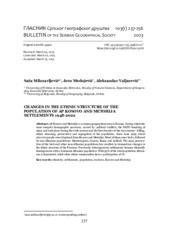Приказ основних података о документу
Changes in the ethnic structure of the population of AP Kosovo and Metohija settlements 1948-2022
Промене у етничкој структури становништва насеља АП Косово и Метохија у периоду од 1948- 2022. године
| dc.creator | Milosavljević, Saša | |
| dc.creator | Medojević, Jovo | |
| dc.creator | Valjarević, Aleksandar | |
| dc.date.accessioned | 2023-11-27T14:49:29Z | |
| dc.date.available | 2023-11-27T14:49:29Z | |
| dc.date.issued | 2023 | |
| dc.identifier.issn | 0350-3593 | |
| dc.identifier.uri | http://gery.gef.bg.ac.rs/handle/123456789/1628 | |
| dc.description.abstract | AP Kosovo and Metohija is a unique geographical area in Europe, during which the most complex demographic processes, caused by: political conflicts, the NATO bombing of 1999, and took place during the 20th century and the first decades of the 21st century: killing, ethnic cleansing, persecution and segregation of the population. Since June 1999, about 220,000 people were displaced from Kosovo and Metohija. Most of them were Serbs, followed by non-Albanian populations: Montenegrins, Gorans, Roma and Ashkali. The mass persecution of the Serb and other non-Albanian populations has resulted in tremendous changes in the ethnic structure of the Province. Previously, heterogeneous settlements became ethnically homogeneous with a dominant Albanian population. With 93% of the total population Albanians is dominated, while other ethnic communities have a participation of 7%. | |
| dc.description.abstract | АП Косово и Метохија је јединственa географскa регија у Европи, у којој су се током ХХ и првих деценија ХХI века одвијали најсложенији демографски процеси изазвани: политичким сукобима, НАТО бомбардовањем 1999. године, етничким чишћењем, прогоном и сегрегацијом становништва. Од јуна 1999. године са Косова и Метохије расељено је око 220.000 становника. Најбројнији су били Срби, а затим идруги неалбански народи: Црногорци, Горанци, Роми и Ашкалије. Масовни прогон српског и другог неалбанског становништва довео је до значајних промена у етничкој структури Покрајине. Раније хетерогена насеља постала су етнички хомогена са доминантним албанским становништвом. Са учешћем од 93% у укупном популацији доминирају Албанци, док остале етничке заједнице имају учешће од 7%. | |
| dc.language.iso | en | |
| dc.language.iso | sr | |
| dc.publisher | Beograd : Srpsko geografsko društvo | |
| dc.relation | info:eu-repo/grantAgreement/MESTD/Integrated and Interdisciplinary Research (IIR or III)/43007/RS// | |
| dc.rights | openAccess | |
| dc.rights.uri | https://creativecommons.org/licenses/by-nc-nd/4.0/ | |
| dc.source | Glasnik Srpskog geografskog drustva | |
| dc.subject | ethnicity | |
| dc.subject | settlements | |
| dc.subject | population | |
| dc.subject | enclaves | |
| dc.subject | Kosovo and Metohija | |
| dc.subject | етницитет | |
| dc.subject | насеља | |
| dc.subject | становништво | |
| dc.subject | енклаве | |
| dc.subject | Косово и Метохија | |
| dc.title | Changes in the ethnic structure of the population of AP Kosovo and Metohija settlements 1948-2022 | |
| dc.title | Промене у етничкој структури становништва насеља АП Косово и Метохија у периоду од 1948- 2022. године | |
| dc.type | article | |
| dc.rights.license | BY-NC-ND | |
| dc.citation.volume | 103 | |
| dc.citation.issue | 1 | |
| dc.citation.spage | 237 | |
| dc.citation.epage | 256 | |
| dc.citation.rank | М51 | |
| dc.identifier.doi | 10.2298/GSGD2301237M | |
| dc.identifier.scopus | 2-s2.0-85163575589 | |
| dc.identifier.fulltext | http://gery.gef.bg.ac.rs/bitstream/id/3484/0350-35932301237M.pdf | |
| dc.type.version | publishedVersion |


